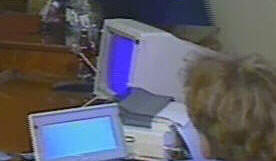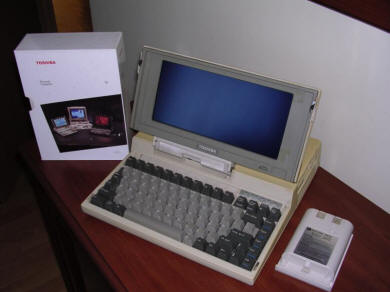Toshiba T1200
Toshiba T1200 was successor of Toshiba 1100 Plus, the
first mass market laptop computer. It had Intel 80C86 processor and 1MB
of RAM, in which 640kB could be used in DOS and remaining 384kB as LIM
EMS memory for applications. Base models had two 3.5" drives, while
better ones had one floppy disk drive and 20MB hard disk. This disk
had a special controller and interface designed by Ricoh and JVC, this
interface was something between ST412 and XT/IDE, being incompatible
with both, so there are no other drives for it. Floppy drive is also
non-standard.
Toshiba T1200 has 3 batteries, so if you want to avoid leak you should
better remove both from inside (CMOS and RAM batteries, don't short
wires inside!). Main battery is easily replaceable and is used to
power the computer, while the second, internal, powers RAM to create
non-volatile "RAM disk". CMOS battery helps circuit to store
information about FDD/HDD used and ticks RTC.
T1200 has two power switches, one turns computer on and off, second one
allows to turn hard drive off to save battery.
It was possible to connect external 5.25" floppy disk drive and external
numerical keyboard (numpad) using dedicated serial interface.
Later, Toshiba introduced T1200xe, a T1200 with 80C286 processor.
| Manufacturer | Toshiba | |
| Origin | Japan | |
| Year of unit | 1988 | |
| Year of introduction | 1987 | |
| Type | Laptop, PC | |
| CPU | Intel 80C86, 4.77 / 9.56MHz | |
| RAM | 1MB | |
| Floppy Disk | 3.5", 720K | |
| Hard Disk | 20MB, JVC/Ricoh interface | |
| Other media | None | |
| Graphics and display: | CGA with monochrome backlit LCD, 16 gray shades. | |
| Sound: | PC Speaker | |
| Keyboard and pointing device: | 82-key full-scale keyboard. | |
| OS: | MS-DOS 3.3 | |
|
Power supply: |
||
|
1 - Ground |
||
| I/O: | - Serial port - Parallel port - CGA out (DB9) - TV Out (Composite) - External numpad connector (dedicated) - External floppy |
|
| Possible upgrades: |
- RAM Expansion to 5MB with special modules. - External FDD - External numpad - dedicated interface. - Special internal expansion bus - Internal modem |
|
| Additional peripherals: | Battery, manuals set. |
I have two units, one damaged, unfortunately I don't know exactly what is damaged, second one works. First one is from electronic junk from Germany, second was used in Polish railways to write spedition reports. They of course had no Polish keyboard driver and used ALT+FN +ASCII Code to write Polish diacritized characters... for 20 yaers :D. As I got it there was even a sticker with codes for each Polish letter!
|
|
You should get Setup tools for it to switch speed, power saving, backlight and LCD/CRT or power save by disabling modem. Toshiba will boot any DOS 3.3, 4.0 or later. It's completely PC compatible, you can use it as every PC XT. |
|
|
Some interesting PDFs: |
|
|
ROM |
| Contents: | Hard Disk | FDD Pinout |
This information won't let you fit any other hard disk,
but I think it may be useful if you plan to do something with deep
electronics:
HDD: JVC Model JD-3824G (earlier JD-3244)
HDD Geometry: 615 cylinders (HDC supported 612), 2 heads (Logically 4?),
34 sectors (?logically 17?)
HDD Coding: 2-7 RLL
HDD Rotation: ?2597RPM?
Pinout:
| 1 | GND |
| 2 | -Read Data |
| 3 | GND |
| 4 | -Write data |
| 5 | GND |
| 6 | Reserved |
| 7 | -Drive Select/+Power Save |
| 8 | -Ship Ready |
| 9 | GND |
| 10 | +Read / -Write control |
| 11 | -Motor On |
| 12 | Head Select (+ head 0, - head 1) |
| 13 | -Direction in |
| 14 | -Step |
| 15 | -Write Fault |
| 16 | -Seek complete |
| 17 | -Servo Gate |
| 18 | -Index |
| 19 | -Track 0 |
| 20 | -Drive Ready |
| 21 | GND |
| 22 | +5V |
| 23 | GND |
| 24 | +5V |
| 25 | GND |
| 26 | +12V |
Where you can find this drive... One can be seen in JVC Philips NMS8260, a prototype MSX computer stylized as set-top box. I think you won't find it easily. GRiD 1520 or similar laptops probably had these drives, but they're more rare exhibit than Toshiba.
All pinouts I have. Maybe one is good. Never tried. Comes from some abandoned page from Geocities.
| DB-25 External Floppy Drive Port All laptops except T1100 |
| PIN Input/Output Signal
1 I Drive Ready |
| Toshiba 5.25" 360KB External Floppy Drive DB-25 Connector |
| PIN Input/Output Signal 1 O Ready 2 I Side Select 3 O Read Data 4 O Write Protect 5 O Track 0 6 I Write Gate 7 I Write Data 8 I Step 9 I Direction 10 I Drive Select 11 I Motor On 12 O Index 13-25 Signal Ground |
| Toshiba Laptops to IBM Floppy Drive Toshiba Male DB-25 to 34 pin IBM-style Card Edge connector (shielded) 360KB/720KB Floppy Drive 1.2MB Drive |
| 1 ---------- 33 & 34 Add 2 ---------- 8 6 ---------- 34 3 ---------- 26 14 -------- 2 4 ---------- 28 Change 5 ---------- 30 1 ---------- 33 6-9 ------- not connected 10 -------- 12 11 -------- 16 12 -------- 22 13 -------- 24 14 -------- not connected 15 -------- 32 16 -------- 18 17 -------- 20 18 -------- 19 19 -------- 21 20 -------- 23 21 -------- 25 22 -------- 27 23 -------- 29 24 -------- 31 25 -------- 17 |
| Toshiba Laptops to Toshiba Ext. FDD or Toshiba
PC Floppy Link (Except T1100) (Toshiba PC Floppy Link has 2 position INT/EXT switch) (Toshiba cable) Male DB-25 to Male DB-25 (shielded) |
| 1 ---------- 1 2 ---------- 12 3 ---------- 5 4 ---------- 4 5 ---------- 3 10 -------- 10 11 -------- 11 12 -------- 7 13 -------- 6 15 -------- 2 16 -------- 9 17 -------- 8 18 -------- 21 19 -------- 14 20 -------- 25 21 -------- 18 23 -------- 15,17,22,23,24 24 -------- 20 25 -------- 19 |






